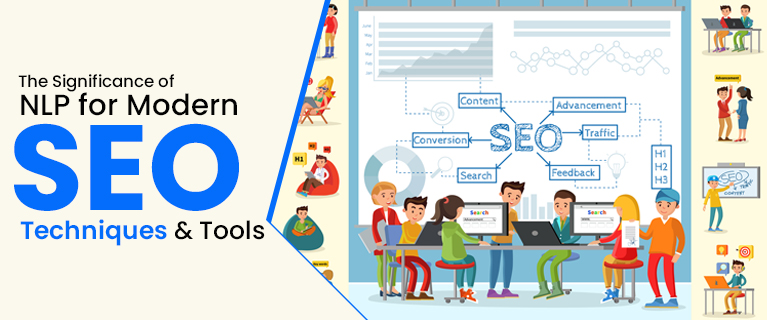In the ever-evolving landscape of Search Engine Optimization (SEO), the shift from traditional keyword-centric approaches to a more sophisticated reliance on Natural Language Processing (NLP) marks a pivotal moment. Gone are the days of simplistic keyword stuffing; contemporary search engines, led by Google, now harness the power of advanced NLP to comprehend user queries and furnish highly relevant results. In this comprehensive guide, we will navigate through the intricate realm of NLP, exploring key concepts that wield influence over modern SEO practices. Furthermore, actionable strategies will be unveiled to empower content creators in optimizing their materials for maximum visibility and impact.
Read Also This – Apple Turned Down A Microsoft Bing Partnership
What is NLP or Natural Language Processing?
Natural Language Processing, a branch of artificial intelligence, endows search engines with the capability to comprehend human language in a manner akin to how humans communicate with each other. Google, being at the forefront of this technological evolution, has incorporated NLP into its algorithms, allowing for a more nuanced understanding of user intent and context. This departure from rigid keyword matching enables search engines to deliver results that align more closely with the user’s informational needs.
One of the fundamental NLP concepts shaping modern Search Engine Optimization is semantic search. Instead of relying solely on exact keyword matches, search engines now prioritize understanding the meaning behind the words. This shift towards semantic understanding has given rise to more conversational and context-aware search queries. As a result, content optimization strategies must adapt to cater to these nuances, emphasizing relevance and context in addition to targeted keywords.
Read Also This – Google Tests Branded Local Service Ads: What Marketers Need to Know
Entities and their relationships constitute another crucial aspect of NLP influencing SEO. Search engines now recognize entities such as people, places, and things, deciphering their interconnections. Consequently, content that establishes clear relationships between entities gains favour in search rankings. Crafting content that not only incorporates target keywords but also builds meaningful associations between entities can significantly enhance visibility in search results.
User experience, a perennial SEO cornerstone, takes on a new dimension with the integration of NLP. Google’s focus on understanding user intent prompts content creators to prioritize delivering valuable and contextually relevant information. Crafting content that directly addresses user queries and provides comprehensive, authoritative answers aligns with the evolving criteria of search engine algorithms.
As voice search continues to gain prominence, the impact of NLP on SEO becomes even more pronounced. Voice queries often mimic natural language more closely, necessitating a shift towards content that mirrors conversational tones and addresses specific user inquiries. This shift underscores the importance of creating content that resonates with users not only in written form but also in spoken language, catering to the diverse ways in which people interact with search engines.
Read Also This – Microsoft Bing’s Incremental Gains in the Search Market
In the subsequent sections of this guide, we will delve into actionable strategies for optimizing content in the era of advanced NLP. From understanding user intent to leveraging semantic markup, each strategy is designed to empower content creators in navigating the intricacies of modern SEO. As the digital marketing landscape continues to evolve, staying abreast of NLP developments and adapting SEO strategies accordingly will prove instrumental in achieving and maintaining online visibility.
1. Understanding How Machines Process Language:
In the realm of Natural Language Processing (NLP), the fundamental comprehension of how machines interpret human language is pivotal. Unlike humans who understand words and concepts, machines process language as signals and noise, requiring a series of techniques to transform text into a format understandable to computers. Tokenization, a key process in NLP, involves breaking down text into individual units or tokens. This segmentation enables machines to analyze and interpret language effectively. Additionally, vectorization, another foundational technique, transforms words into numerical representations. These numerical vectors allow machines to recognize patterns and relationships, forming the basis for language processing.
Read Also This – The Importance of Web Hosting for SEO
2. Debunking LSI Keywords: Myths and Realities:
The concept of Latent Semantic Indexing (LSI) keywords has been prevalent in Search Engine Optimization (SEO) strategies. However, modern SEO practices have shifted away from direct reliance on LSI keywords. Contrary to popular belief, search engines like Google no longer prioritize these specific keywords. Instead, the focus has shifted towards more advanced NLP techniques. This evolution in SEO emphasizes a deeper understanding of user intent and context, surpassing the limitations of traditional keyword-centric approaches.
3. The Role of Entities in SEO:
Entities, whether in Google’s Knowledge Graph or as lower-case entities, play a crucial role in shaping contemporary SEO strategies. The “web of entities” refers to the interconnected relationships between various entities, and understanding this web is instrumental in crafting content that aligns with user goals and search queries. By incorporating relevant entities into content, websites increase their likelihood of being deemed relevant by search engines, thereby enhancing their visibility.
4. Named Entity Recognition (NER) Explained:
Named Entity Recognition (NER) is an advanced NLP technique that automates the identification and classification of named entities within a body of text. This includes recognizing entities such as names, locations, organizations, and more. NER employs various approaches, including rule-based systems, statistical models, and deep learning models. Practical implementation examples using Python’s NLTK and spaCy libraries showcase the versatility and effectiveness of NER in real-world applications.
Read Also This – Google’s Battle Against Manipulative Tactics in LSAs
5. Neural Matching and BERT in Search:
Google leverages sophisticated NLP techniques like neural matching and BERT (Bidirectional Encoder Representations from Transformers) to enhance its understanding of user intent in search queries. Neural matching allows Google to read between the lines, comprehending the context and nuances of user queries. BERT, on the other hand, is designed to process complex queries by considering the relationships and order of words within a sentence. These advanced techniques contribute to more accurate and context-aware search results, improving the overall search experience for users.
6. Beyond Keywords: Large Language Models (LLMs) and Retrieval-Augmented Generation (RAG):
The landscape of language models has evolved with the advent of Large Language Models (LLMs) like GPT (Generative Pre-trained Transformer). These models are trained on vast datasets, enabling them to generate human-like text and understand intricate language nuances. Additionally, innovative approaches such as Retrieval-Augmented Generation (RAG) combine generative capabilities with information retrieval, offering a unique way to enhance content accuracy and credibility. RAG, in particular, leverages both generative language models and pre-existing knowledge, providing a more nuanced understanding of information retrieval.
7. Applying NLP Techniques to Your Content:
Practical implementation of NLP techniques in content creation involves several key strategies. Firstly, identifying key entities within the text helps in understanding the core elements and themes. Analyzing user intent allows content creators to align their material more closely with user expectations, enhancing the overall user experience. Improving readability and engagement through NLP techniques involves optimizing the content structure, ensuring it is accessible and engaging for diverse audiences. Semantic analysis for content expansion explores the possibilities of leveraging NLP to generate additional relevant content, thereby enriching the overall informational value. Python scripts using NLTK and spaCy libraries are valuable tools for content creators, offering efficient and effective ways to incorporate these NLP techniques into their content creation workflows.
Read Also This – Best SEO Optimization Techniques for Your Website
In conclusion, attaining proficiency in Natural Language Processing (NLP) for contemporary Search Engine Optimization (SEO) necessitates a comprehensive comprehension of the intricate mechanisms through which machines interpret and process language. One pivotal aspect of this mastery involves harnessing the power of entities, recognizing the importance of entities within content to facilitate more accurate and context-aware search engine understanding.
Furthermore, embracing advanced NLP techniques, such as neural matching and BERT (Bidirectional Encoder Representations from Transformers), is crucial for staying at the forefront of SEO optimization. Neural matching enables search engines to better comprehend user queries and match them with relevant content, enhancing the overall user experience and boosting the chances of your content being surfaced in search results. BERT, with its ability to grasp the nuances of language and context, empowers search engines to deliver more precise and relevant results by understanding the intent behind user queries.
Moreover, the integration of large language models and retrieval-augmented generation techniques is paramount in elevating your SEO strategy to new heights. Leveraging these sophisticated models allows for the creation of content that not only aligns with user intent but also outshines competitors in search engine rankings. The synergy between large language models and retrieval-augmented generation enhances the content creation process, ensuring that it resonates effectively with both users and search engine algorithms.
Read Also This – Microsoft Enhances Its Capabilities for Ad Targeting
Incorporating NLP techniques into your content strategy is not merely a trend but a strategic imperative. By doing so, you not only cater to the evolving expectations of search engines but also deliver a more meaningful and engaging experience to your audience. The symbiosis between advanced NLP and SEO is a dynamic force that can propel your website’s visibility in search engine results, solidifying its position as a prominent player in the digital landscape. As search algorithms continue to evolve, mastering NLP remains a cornerstone for staying ahead in the ever-changing realm of SEO.
Read Also This – Google’s Revised SEO Starter Guide



